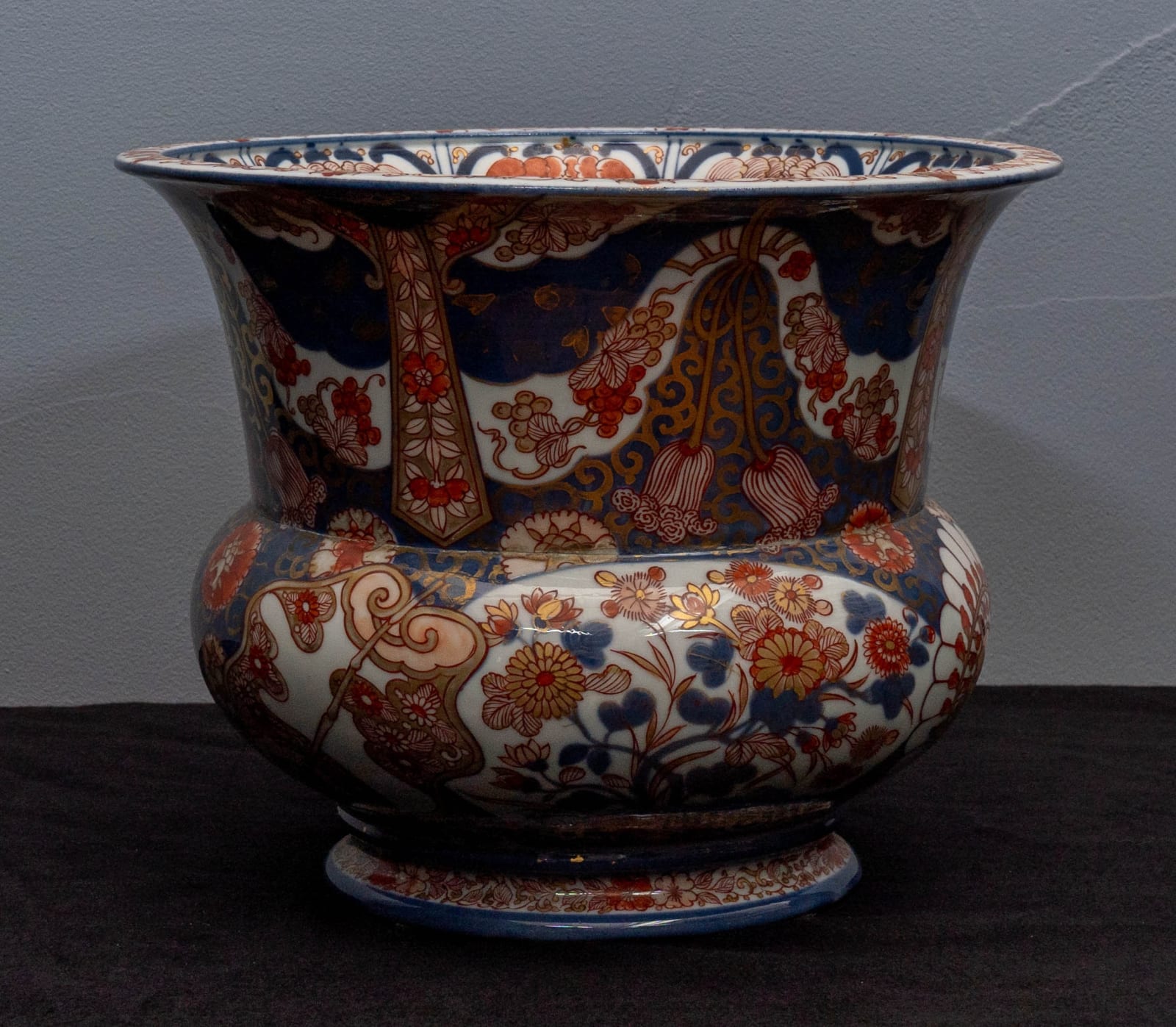Unknown
A very elegant late nineteenth century French porcelain jardinière in the Japanese Imari style attributed to Samson, Edmé et Cie, the jardinière with an outwardly splayed circular rim, a long slightly tapering neck and rounded body on a circular foot, decorated overall with underglaze blue and red enamels and gold featuring peonies, chrysanthemums, plum blossom and other flowers within a variety of shaped cartouches and panels, with the decoration continuing to the interior, bearing various Oriental characters in blue underneath
Montreuil, France, date circa 1880
Height 31cm, width 44cm.
In terms of its colouring and decorative details, this highly attractive jardinière shares many characteristics with Japanese Imari porcelain. However, it was not made in Japan but in Europe, most probably by the firm of Samson, Edmé et Cie. What differentiates it from true Imari porcelain is its high glossy sheen, its overall shape, which was better suited to European tastes and use, and also the way in which the individual decorations are applied. The firm of Samson, Edmé et Cie, which produced high quality copies or imitations of earlier porcelain styles was founded by Edmé Samson (1810-91), who was later joined by his son Emile Samson (1837–1913). Born in Paris in 1810, Edmé Samson began his career as a painter of ceramics, initially decorating white porcelain blanks that he purchased from other factories. His background as a decorator rather than a potter was crucial to the development of his factory’s distinct identity. By the mid nineteenth century, as demand for antique and exotic objects increased, Samson began producing his own porcelain wares, seeking to fill the gaps in museums and private collections and meet the growing appetite for Asian art.
Having begun his career by making service and set piece replacements during the late 1830s, Samson then set up a business in 1845 at 7, Rue Vendôme (later Rue Béranger) in Paris. Later, he, partnered by his son Emile then opened up larger premises in Montreuil, where between 1864 and 1870 they began producing porcelain. The firm gained renown for creating reproductions of not only Japanese Imari ware but also Chinese famille rose and famille verte porcelains, Persian ceramics, delftware, Italian faience and maiolica as well as a range of copies or adaptations of pieces by the Meissen, Sèvres, Chelsea, Worcester and Derby factories. Edmé Samson was not alone in his pursuit. Other European ceramic factories were also engaged reproducing Japanese Imari and other Oriental style porcelains.
In England, the Worcester porcelain factory produced wares that incorporated Imari elements as early as the eighteenth century, with continued production through the 1800s. Royal Crown Derby went even further and developed a signature ‘Old Imari’ pattern that became iconic in its own right. Unlike Samson, whose focus was on direct stylistic imitation, these British factories were integrating Japanese design elements into new compositions suited to Western functions and sensibilities.
In Germany, the Meissen manufactory had its own tradition of Japanese-inspired porcelain, dating back to the early eighteenth century. Meissen’s Kakiemon and Imari patterns were created not from original contact with Japan but through the mediation of imports via the Dutch East India Company. By the nineteenth century, Meissen and other German factories, such as Berlin’s Königliche Porzellan-Manufaktur (KPM), continued to revisit Japanese motifs, often combining them with Rococo or Neoclassical European shapes. These productions were less about copying and more about reinterpretation.
In France, the Sèvres manufactory occasionally experimented with Oriental styles, though it was generally more inclined toward Neoclassical and courtly aesthetics. However, Sèvres porcelain did take part in the Japonisme trend during the latter half of the nineteenth century, though it was private firms such as Samson’s that were more flexible and commercially responsive, producing for a clientele eager for visual variety and historical pastiche.
What distinguished Samson’s output was not merely mimicry but a synthesis of artistic knowledge and technical skill. His firm’s aim, at least ostensibly, was to offer collectors affordable and beautiful replacements or supplementary pieces to their collections, rather than to deceive. Many of Samson’s items were clearly marked with an “S” or other indicators, although these could be removed or ignored by later dealers hoping to pass the objects off as genuine antiques. In the context of the nineteenth century, the line between reproduction and forgery was thin, but Samson’s intentions leaned toward education and accessibility rather than fraud. The company continued to operate up until 1969 and then ten years later Christie’s, London, sold their saleroom models.



